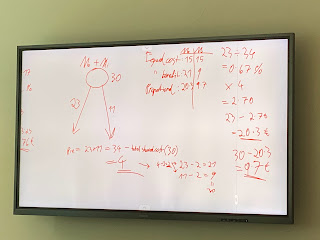Organizational Behavior Session 9 and 10
Session 9 and session 10 were the last classes that we had for this term so we started the class with the group presentation by Roman and Filippo. Then Chanakan, Awal, Milana and I did the second group presentation. The professor asked and answered many meaningful questions before we move on to the review for the final exam—which is always nice to know what will come out. Then, we moved on to understandingg the role at which Human Resource Management plays in a companies innovation and the strategy development process. To understand it better, the professor asked us to do a case study about Swisscom and let us try to relate it to the concepts and theories that we have learned so far in class. As the case study was more about the internal discussions and methods of the top management, it was difficult to try and relate it to the theories. I had to do the disruptive innovation process to which I answered:
Swisscom became to innovate while their core business was still strong or at least not going downhill. Operating in a saturated market, Swisscom was under pressure from other players. The company focused on bridging out – but with specific targets in mind. So they tried to protect their business by focusing on and integrating around the job to be done. Swisscom determined that more soft skills were needed to manage the continuity of disruption and then set about acquiring them. They invested more than 100 million CHF into startups. Learned from startups about innovation culture and structure and developed disruptive field of growth and offer clients innovative products. All in all, Swisscom has an autonomous culture that ensures the company’s success because employees and divisions are aligned with a clear vision.
I also asked the professor whether a company can be both a sustaining innovation and a disruptor and it turns out that it is possible that it could happen because while Swisscom was trying to develop their current business model further. They were also branching out and craeting new markets and values to their investments in young entrepreneurs and start-ups. There is also not just one exclusive disruption pattern that is identifiable for a company. Because the analysis might be understood differently by many people, there is not only one that can be chosen. In addition, once the pattern was recognized, we looked at the possible replies and how Swisscom dealt with the interruption. We then assessed the degree of disruption based on the stage of innovation, its speed, and its impact on the industry. With the formulation of their new plan Swisscom 2025, we decided that Swisscom was ahead of the curve in defending itself from any possible threat. However, due to constant technological advancements and adaptive speed, the pace and effect of the disruption will be considerable. Moreover, Swisscom was approaching the improvement with a deliberate strategy. Another risk came about as they were missing out on other opportunities when using a structured approach, as shown in their research that the cost of missed opportunities other than achieving a revenue target is immense. We also spend some time trying to understand the concept of the action pattern. Depending on the degree of disruption, the plan of the action for the company will vary.
We ended the class with a reminder of what is expected to come on the exam and overall, it was such an amazing journey over the course of four weeks. The concepts and theories were hard to grasp at first but with the usage of real life applications and case studies, it made learning much more simpler and easier to understand.

Comments
Post a Comment